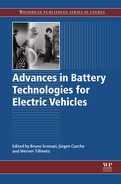Introduction to hybrid electric vehicles, battery electric vehicles, and off-road electric vehicles
F. Herrmann; F. Rothfuss Fraunhofer Institute for Industrial Engineering IAO, Stuttgart, Germany
Abstract
The finite nature of the fossil fuel supply, strong regulations such as the CO2 limits and the wish for pollution-free mobility has led to a great variety of electric drives for road and off-road vehicles. Beside various hybrid propulsion technologies, there exist battery electric and even fuel cell electric concepts. Each system configuration has unique advantages and disadvantages and is suitable for different applications. Therefore the battery technologies play an important role in fulfilling the numerous requirements in shown vehicle concepts. This chapter as a general introduction gives an overview of the whole range of electric drives for different applications, guiding readers to the following chapters that focus on the advances in one of the key research fields “battery technologies for electric road and off-road vehicles”.
1.1 Electric mobility: mobility of the future
1.1.1 The importance of electric mobility to overcome future challenges
A current topic of discussion is how to overcome future challenges to society, including climate change and the finite nature of fossil fuels. One result will be the enactment of stricter regulatory requirements in upcoming years regarding the reduction of CO2 emissions caused by conventional vehicles. For example, in the European Union (EU), cars are responsible for approximately 12% of total EU emissions of carbon dioxide (CO2), “which can be seen as the main greenhouse gas” (European Commission, 2013). The CO2 targets that the European Union legislated in 2009 and which were settled by the European Commission in July 2012 provide that the fleet average to be achieved by all new cars is 130 grams of CO2 per kilometer (g/km) by 2015. The target to be achieved by 2021 was set to 95 grams of CO2 per kilometer (g/km) (European Commission, 2014).1
Other factors include strong urbanization and the general population’s increasing interest in environmental issues; these factors indicate the need for pollution-free alternatives to the existing conventional vehicles that are driven by internal combustion engines (United Nations, 2012; Foth and Hellwig, 2011). Additionally, a change is evident in people’s behavior concerning vehicle ownership and the acceptance of new forms of mobility, such as car sharing, which also enables the potential for electric vehicles in current society (Bratzel and Lehmann, 2010).
There is a need for change not only in tomorrow’s passenger cars but also in buses and off-road vehicles. All of these can benefit from recent developments in electric propulsion systems. In addition to the issue of rising fuel prices, the working costs of these vehicles over their life cycles are enormous, and these issues can be regarded as a good point of action for solutions based on electric mobility.
1.1.2 Existing technological fundamentals and potential development paths
Every electric propulsion system is based on key components that make the concept work. The most important components are the energy storage device (battery system),2 the electric machine, the power electronics, and a suitable charging device.
The energy storage device in general plays a significant role in determining technical attributes such as performance and range. Energy storage devices can be differentiated by type of rechargeable battery (e.g., lead-acid, nickel-metal hydride, or lithium-ion [Li-ion] battery), capacitors, or use of hydrogen as an energy source together with the fuel cell working as an energy converter. The different battery alternatives vary in their gravimetric energy density (Wh/kg) and their power density (W/kg).3 Compared to other types of energy sources (e.g., hydrogen or gasoline), the secondary batteries have a significant lower energy density. However, this disadvantage is compensated to a certain degree by the higher efficiency of the electric drivetrain as compared to conventional combustion engines.
The user must install several battery packs in the vehicle to ensure a certain level of range, although this leads to a higher overall vehicle weight under today’s state of technology (Spath et al., 2011; Eckstein et al., 2010). In addition to energy density, other aspects that must be considered when selecting the appropriate storage system include power density, lifetime and safety aspects, usable capacity (depth-of-discharge), and storage system costs (Oertel, 2008; Spath et al., 2011). To guarantee performance, many different subsystems are developed within the battery system (e.g., a battery management system or a suitable thermal management system).
Under current development conditions, there is not just one suitable energy storage device. The different types available have unique advantages and disadvantages, each of which must be considered together with the whole drivetrain architecture, and always along with the requirements of the application chosen.
Within an electric propulsion system the core component of the electric machine4 can improve, extend, or even replace the combustion engine as a propulsion source. For example, in the concepts of the range-extender vehicle, the battery electric vehicle (BEV), or the fuel cell vehicle, the electric motor is defined as the single propulsion source.
Unlike the combustion engine the electric machine has an outstanding torque characteristic (maximum torque is available from 0 revs per minute [rpm]), which makes the electric machine a great choice for the propulsion motor in vehicles. Furthermore, electric machines are characterized by high efficiency (90% or more), robustness and long service life, low maintenance costs, and a relatively low noise level (Spath et al., 2011; Franke, 2011).
Electric machines can be differentiated as direct or alternating current machines. Because of their relevance to vehicle applications, we will look at the function of the alternating current machine. These machines are driven by a three-phase alternating current. For the functionality of the drive, the three alternating voltages are each offset by 120 degrees. They feed the stator windings to generate a rotary magnetic field inside the motor, which is then followed by the rotor of the machine. The fact that the direct current from the battery has to be transformed into alternating current for the electric machine makes the existence of a so-called inverter one of the main components of the power electronics (Freialdenhoven, 2009; Mathoy, 2010; Hofmann, 2010).
In addition to the battery system and the traction motor, the power electronics can be regarded as one of the key technologies in electric vehicles (Strehlitz 2012). The power electronics module within an electric drive system has several tasks that are very important to the overall economy and efficiency of hybrid and electric vehicles. As mentioned, the direct current from the battery system must be inverted into alternating current for the electric machine (or vice versa in the case of recuperation). This functionality is one of the main tasks. The power electronics module must also convert the voltage to different levels (stepping up or down) to ensure the onboard power supply. Furthermore, the power electronics are crucial for the charging process (Spath et al., 2012).
The charging device is used to charge an electric vehicle externally via the grid. The device must adapt the external current to the voltage needed to charge the battery. Currently there are two different charging device options from a technical point of view. Either the charger is installed in the vehicle (called an on-board charger) or it is installed as an external device at the charge column (called an off-board charger). On-board chargers are widely used in today’s electric vehicles (3.6–22 kW).5 The off-board solution is more likely used for fast charging operations, which can be up to a power of 50 kW or more. Different options are available for the charging process, leading to a discussion about standardization of the charging process by itself but also about the necessary components and connector systems. Figure 1.1 shows an example of one possible topology of the power electronics and their interaction with the energy storage system and the electric machine.

1.2 Overview of different electric propulsion systems
Propulsion systems for vehicles can generally be classified into conventional systems powered solely by an internal combustion engine6 and electric propulsion systems. In the following, all propulsion concepts that can cover at least a portion of the distance propelled purely by electricity are classified into this second class, no matter whether they receive the energy from a battery or from a fuel cell system (Spath et al., 2011).
The variety of electric propulsion systems is big and can either be differentiated by the range of hybridization (micro-7, mild, full-, or plug-in hybrid) or the architecture of the drivetrain. For the architectural view, the configuration of the powertrain components, that is, the combustion engine, transmission, electrical motor (including power electronics), generator, or battery is important (Hofmann, 2010). Based on the configuration, the three types—serial, parallel, or power-split hybrid—can be differentiated. Figure 1.2 shows the range of electric propulsion systems.
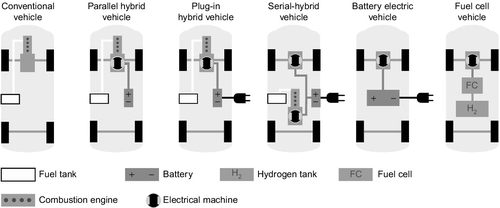
In the following, we look at the different drivetrain architectures (Braess 2013; Hofmann, 2010; Spath et al., 2011; Spath et al., 2012; Wallentowitz, 2010).
1.2.1 Parallel hybrid or power-split hybrid
A parallel hybrid or power-split hybrid is the classic hybrid concept. The electric motor works as a support for the combustion engine. The drive train architecture can either be a parallel hybrid or be a power-split hybrid. In many cases pure electric propulsion is possible over a short distance. The battery is recharged over the recuperation function. Depending on the degree of support from the electric motor, these hybrid vehicles can be classified as either mild or full hybrids. Whereas in the case of the mild hybrids, the range of the electric power typically differs between 5 and 20 kW, full hybrids are now equipped with an electric power between more or less than 30–50 kW. The battery capacity normally ranges between 1 and 2 kWh.
1.2.2 Plug-in hybrid vehicle
The propulsion concept of the plug-in hybrid vehicle (PHEV) is an intelligent combination of a conventional combustion engine with an electric motor. Depending on the battery size and use, a solely electric propulsion is possible over an adequate distance. In addition to the classic hybrid, it has the advantage of being charged on the grid. Compared to the mild- or full-hybrid types, plug-in hybrid vehicles usually have a more powerful electric traction motor. The range can be set somewhere between 30 and 80 kW. Also the battery capacity is higher and can normally vary between 3 and 10 kWh.
1.2.3 Range extended electric vehicle
The range extended electric vehicle (REEV) is propelled by a powerful electric motor. It has a smaller combustion engine with restricted power for charging the traction battery over an additional generator. As the architecture can be classified as a serial hybrid, the combustion engine has no connection to the drive axle. The option to charge the battery at the grid is also given in this concept. Nowadays range extended electric vehicles do have a powerful electric traction motor (often more than 100 kW) and a battery capacity somewhere around 15 kWh.
1.2.4 Battery electric vehicle
The battery electric vehicle (BEV) has a powerful electric motor and a well-dimensioned battery system. The vehicle is propelled only by the electric motor so that no combustion engine, fuel tank, or even exhaust system is needed. The vehicle is charged either by recuperation or by the power grid. As there is a wide range of vehicle concepts for pure electric vehicles, the technical features regarding the electric motor or the capacity of the battery can differ considerably. Compact cars currently have a capacity of around 15–25 kWh, whereas vehicles in premium segments can be equipped with a battery system with a capacity of 60 kWh or more.
1.2.5 Fuel cell vehicle
The propulsion concept of the fuel cell vehicle (FCEV) in comparison to the previously discussed electric drive systems is that hydrogen is used as the energy source stored in a special hydrogen tank. The fuel cell system works as an energy converter supplying the electric motor. The traction motor in existing fuel cell vehicles is in the range between 30 and 100 kW. This propulsion concept has a smaller dimensioned battery (1–2 kWh) for the function of recuperation.
As evidenced by the large variety of different propulsion systems, there is not just one right application. In terms of vehicle concepts, there is a difference between vehicles of personal transport such as passenger vehicles or two wheelers, public transport vehicles including buses, or off-road vehicles such as different types of mobile working machines. For each type of application, different propulsion systems have to be analyzed for their suitability. Figure 1.3 demonstrates one alternative way to determine the fit between propulsion system and application. Therefore the two dimensions of “driving profile” and “load profile” have been chosen.
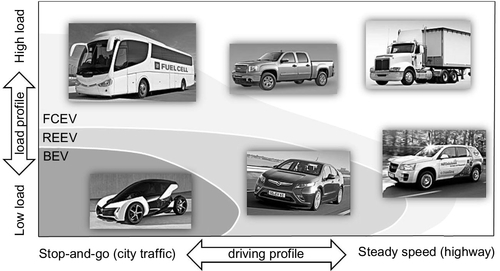
As we have already seen, there is not just one right solution for tomorrow’s mobility. The existence of the different propulsion systems and their use in various applications require extensive technological knowledge, which has to be further developed in many ways.
1.3 Advantages and disadvantages of electric vehicles
Electric mobility can be regarded as a cross-industry development. Although the combustion engine technology is fully industrialized, electric propulsion systems for the use of the automotive and off-road industry are still in a very early stage of their industrialization. In addition to the changes in the key components of a vehicle, several more aspects have to be considered when talking about the advantages and disadvantages of electric vehicles. In that context new ways of energy consumption and supply have to be discussed. The current strong dependence on fossil fuels is one of the most important issues when talking about future mobility. To increase the amount of renewable fuels, electricity based on renewable sources and hydrogen can be considered to be suitable alternatives (Thiesen, 2011). Additionally there are new research fields and activities regarding information technologies and the connectivity of vehicles and their surroundings which can benefit from the latest developments within electric propulsion systems. Together they could provide interesting mobility solutions to commonly known and conventionally driven vehicles.
Considering electric vehicles in general, there are some quite obvious advantages as well as disadvantages when comparing them to the original solutions based on conventional combustion engines. The functional principle of the electric propulsion system provides some clear advantages to this solution when it comes to the efficiency of the system. Compared to systems based on combustion engines, electric propulsion systems work far more efficiently. Some electric motors can reach an efficiency of up to 95% or more, which is about three times higher than the efficiency of a combustion machine (Spath et al., 2011). On the other hand, one of the big disadvantages is the relatively heavy weight of the electric propulsion system, especially in the case of the hybrids. The electric machine (and, in some cases, the electric generator), the power electronics, and the heavy battery system combine for more weight than the combustion engine. As a compensation for the heavy battery system, however, is another advantage to the storage device—its rechargeability. This can be achieved either through the recuperation function or through the charging option via the grid. An advantage when evaluating the comfort or the drive characteristics is the outstanding acceleration and power transfer of the electric system over the conventional system. The relatively low energy density of today’s batteries, which results from the complex development in battery science, is one main disadvantage. Improvements have been achieved in the last couple of years in the fields of material, cell design, and processability.
The costs of electric vehicles remain a disadvantage in the current development state owing to the early level of industrialization, limited product range, and overall low market sales. The key components of electric vehicles, especially the battery systems, are very expensive. Much work remains to be done in the assurance of quality aspects in existing production sites. However, the acquisition cost of the electric vehicle is not the only criteria when it comes to evaluating the economic feasibility of the vehicle. Life-cycle costs also have to be taken into account. Lower maintenance costs and reduced efforts for energy are big advantages when considering all costs of the vehicle over its lifetime.
Another benefit is the local-free emissions of electric vehicles. Especially in urban areas, this is one of the major advantages; they reduce pollution in cities and lead to an environmentally friendly image. But to achieve the full potential of electric propulsion systems, the energy mix in today’s power generation has to be changed to a more sustainable system by increasing the amount of regenerative energy sources. Additionally the carbon footprint of vehicles over the entire product life cycle has to be monitored and optimized regarding the CO2 emissions in the process chain, only than electric vehicle concepts can use their potentials (Sammer et al., 2011; Spath et al., 2011).
Table 1.1 summarizes the advantages and disadvantages of electric vehicles. This list does not encompass only the advantages or disadvantages of a purely technical nature but also includes ecological and sustainability characteristics.
Table 1.1
List of selected advantages and disadvantages of electric vehicles
| Field of action | Advantage | Example | Disadvantage | Example/reason |
| Powertrain and storage | High efficiency of the powertrain | Efficiency of 90% or higher contrary to ~ 30% of combustion engines | Many electric propulsion systems (e.g., hybrid-electric) are very heavy | Sizable battery system needed to support reasonable range |
| Battery technology | Rechargeability of the battery system | Charge option via grid or recuperation | Limited cycle time and complex cell technology | Complex development in battery science (e.g., materials, processability) |
| Comfort/drive characteristics | Outstanding acceleration and power transfer compared to combustion engine technology | Torque characteristic of electric motor | Limited electric range | Low energy density of today’s batteries |
| Vehicle concept | New vehicle concepts are developed | Purpose design (e.g., BMW i3) | High effort regarding new design concepts | Know-how in new process technologies and materials required (e.g., carbon fiber reinforced plastics) |
| Costs | Decreasing life-cycle costs | Lower Maintanance costs | High components costs | For example, current battery price estimations per kWh ~$250–$600 (depending on cell geometry and battery type) |
| Ecology/sustainability | Local free emission of electric drives | No CO2 emission while in use | Today’s overall carbon footprint | Today’s energy mix (not 100% sustainable) |
| Energy (storage, charging process) | Smart energy solutions | Integration of EVS into smart grids | Today‘s Infrastructure | Only few public charging stations |
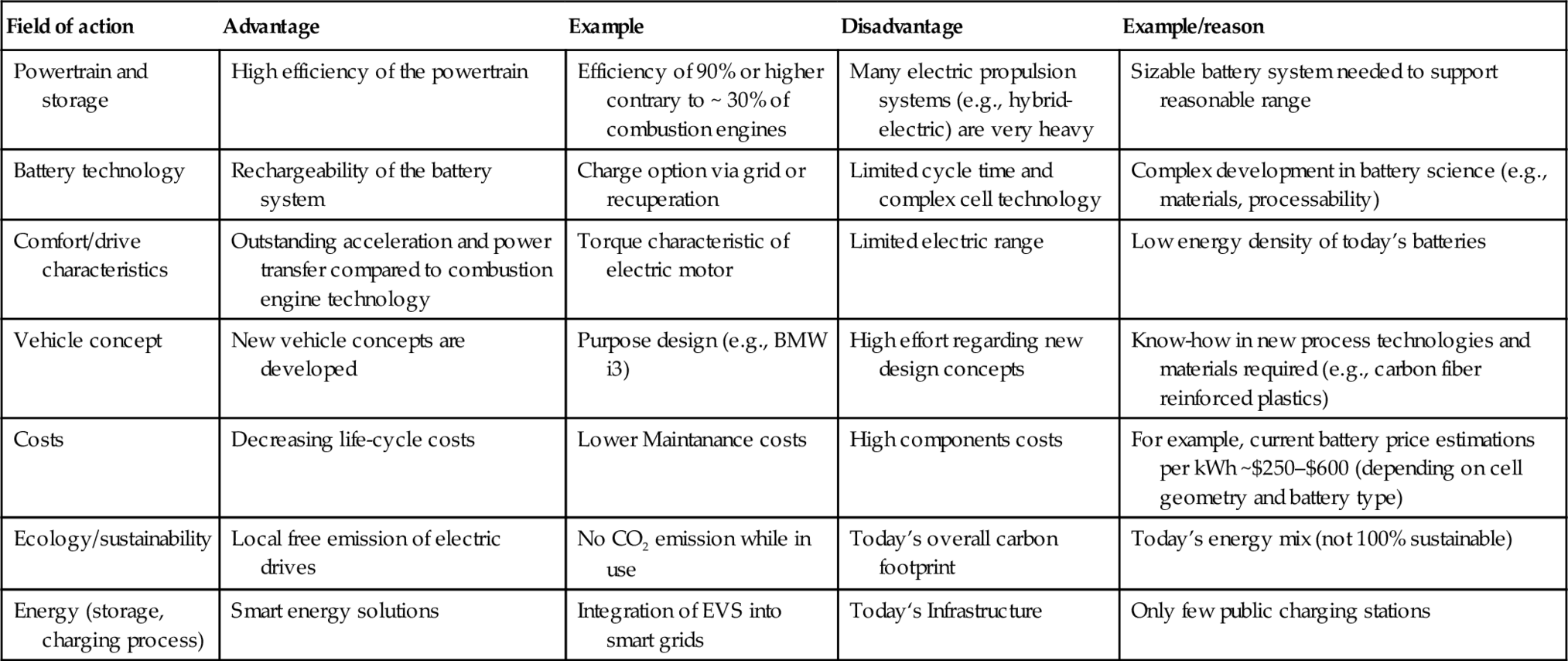
In addition to the more general advantages, there are clear benefits for electric road and off-road vehicles when regarding different applications in their typical use. One example is in the use of electric vehicles in the delivery business in urban areas. Because the maximum range of the electric vehicle isn’t reached when only local deliveries are made, there can be some quite good fuel savings. In some cases, they can reach a cost savings of approximately 20% as compared to a diesel equivalent. Other benefits are the fast acceleration in urban traffic and the potential for lower maintenance costs because of fewer mechanical parts in the propulsion system (Department of Transport, 2010).
1.4 Applications in the field of electric road and off-road vehicles
As there is a large variety of electric road and off-road vehicles, the following chapter gives an overview of both categories in terms of characteristics and known applications. In the European Community there is an enormous set of vehicle categories defined on the primary basis of their technical requirements. The overall aim, therefore, is to support activities in terms of registration, sale, and entry into service of vehicles within the European Community (EG, 2007).
(Electric) road vehicles can be defined as any type of vehicle designed to drive in public transport. The most important categories are passenger cars for individual transport, motorcycles, commercial vehicles, and buses. For each category numerous electric alternatives are in development or even on the market. We have already described existing vehicles in the passenger car market as types of hybrid-, pure electric-, or fuel cell propulsion systems.
Currently, commercial vehicles are widely used in numerous fields of action. Clearly some of them would benefit from the new developments in electric drives. Especially in refuse collection or other municipal activities, hybrid or even pure electric drives are alternatives for commonly used trucks based on the internal combustion engine.
In the case of the bus there are also various forms of hybrid propulsion systems. In addition to the classic drivetrain architecture with a central electric motor, there are alternatives with electric hub motors. One product example in public transport is the Mercedes-Benz Citaro G BlueTec Hybrid (Mercedes Benz, 2013; Figure 1.4).
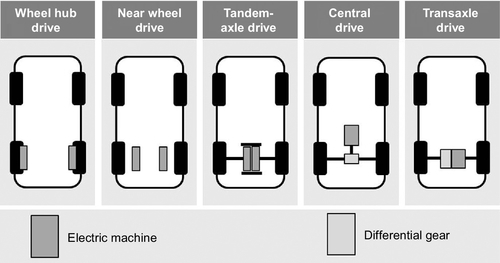
In the field of electric road vehicles there are previously described concepts, some more or less new applications, which cannot be put easily in one of the defined categories. In former times the European Commission subdivided the market of passenger cars, for example, into various segments starting from segment A (so-called mini-cars) ending at segment J (sport utility cars) (Commission of the European Communities, 1999). New electric vehicle concepts such as the Renault Twizy8 do not really fit into the categories for motorcycles or into the passenger car category and initiated a discussion about the need of a new vehicle segment. Another example is the vehicle concept of the so-called pedelecs.9
Compared to the category of road vehicles, the majority of the regarded information sources define the term off-road vehicles as any type of vehicle that is designed to be capable of driving off of public roads, especially on rough terrains such as unpaved roads, trails, and beaches. Off-road vehicles do not include only quads or buggies, but also forklifts, cranes, or wheel loaders and several more (also called mobile working machines) (Beck and Grünbeck, 2012).
These mobile working machines are essential to many industries such as forestry and agriculture and also include specialized urban vehicles (Nijs, 2013). Especially in the agriculture sector, the developments for several applications are strongly influenced by the upcoming exhaust-emission standard Tier 4. To fulfill the necessary requirements new solutions to reduce CO2 emissions are being developed. Agriculture machines with increased electric power (up to 50 kW) are being discussed. One efficient solution for an electric system is a power take-off shaft generator that can bridge the gap between the mechanical tractor and the electric device (Herlitzius, 2013).
Compared to the development of electric road vehicles including passenger cars or trucks, some of the aforementioned off-road vehicles such as forklifts already have a long history of using electric propulsion systems. This current state is a result of the need to avoid exhaust gases inside buildings, such as factories. The trend of integrating electric propulsion systems can also be seen in off-road vehicle applications other than just forklifts.
The combination of a diesel engine and an electric engine inside a wheel loader, for example, leads to a reduced fuel consumption and exhaust emissions. Also, the combustion engine can be downsized and the fuel savings estimated at up to 30%. Generally hybrid drives are ideal for applications with low average power but high peak requirements for a short time. For that reason, a mild hybrid drive can also be used for other off-road vehicles such as excavators, cranes, or airport tow trucks. All of the mentioned vehicles are distinguished by frequent acceleration, short travel distances, and high load peaks. Through these characteristics hybrid systems are able to support the combustion engine by engaging the electric motor as soon as power peaks occur (Figure 1.5a). On the other hand, this sort of off-road vehicle also tends to break down frequently. As a result, excess energy, induced by the braking operation, can be fed back into Li-ion batteries (Geimer and Synek, 2013; Brun, 2008). The concept of using a mild hybrid for an off-road vehicle is generally familiar ever since the first electric hybrid wheel-loader entered the market (Equipment World, 2013).
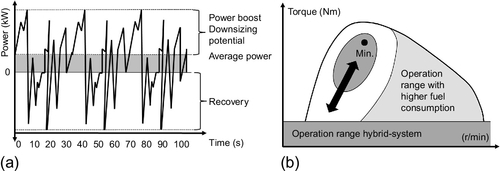
Hybrid drive systems that can be used in wheel loaders or tractors, however, will probably not be a 100% suitable alternative propulsion technology for machines under a full load, such as drilling vehicles, agricultural tractors, or harvesters, because they operate mostly under a full load. In hybrid drive systems for these types of off-road vehicles the electric engine could provide energy to side aggregates, which would originally have been supported with energy by the combustion engine. As a consequence, off-road vehicles under constant and full loads could almost run at their best engine operating point (Figure 1.5b) (Geimer and Synek, 2013; Albers et al., 2008).
Inasmuch as the movement of cargo is increasing permanently between countries and continents, ports will have to be expanded and developed. At the same time, limited exhaust emission standards are being set. In this regard, a wide range of vehicles used at ports (e.g., straddle carriers, reach strackers, terminal tractors, forklifts, mobile cranes container handlers, warehouse stackers, or automated guided vehicles [AGVs]) can also be equipped with hybrid drive systems. In some cases, these vehicles are already available. For example, the Los Angeles Port and the Hamburger Hafen und Logistik AG are investing in emission-reducing and sustainable technologies. In addition to the benefit of fuel savings of up to 30% or more compared to the origin solutions with a combustion engine, these organizations will also benefit from the hybrid system in the forms of lower noise emission, higher lifetime of the components, lower maintenance costs, and a higher availability. Compared to the number of hybrid off-road vehicles inside the forestry and agriculture industries, the range of hybrid mobile working machines for ports is quite comprehensive. Other industries may have the opportunity to learn from the development of hybrid mobile working machines at harbors (Geimer and Synek, 2011).
Although there is already a number of applications, the development of integrating hybrid propulsion technologies inside off-road vehicles has just begun. Until lithium-ion batteries are able to fulfill the required demands for performance, short-time energy storage solutions such as “Supercaps” and hydraulic hybrid systems will be used in hybrid solution systems for off-road vehicles (Geimer and Synek, 2011).
1.5 Conclusion
A wide variety of electric propulsion systems are available as alternatives to commonly known combustion engine-based systems. In the field of electric road and off-road vehicles, numerous applications can benefit from this kind of propulsion system. These applications are not only for the use of passenger transport but also for commercial vehicles and off-road vehicles. In addition to the well-known advantages in the use of an electric concept, there are several deficits in current technologies. For the battery system to be a key component of the electric drive train, it has to fulfill several requirements and be adapted to the different applications. After this short overview to the range of electric drives for different applications, the following chapters will give a closer look at the key research fields of battery technologies for electric road and off-road vehicles.
